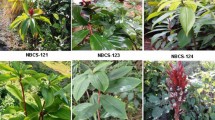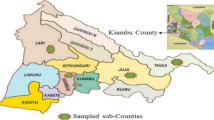Abstract
Guggulsterone is an aromatic steroidal ketonic compound obtained from vertical rein ducts and canals of bark of Commiphora wightii (Arn.) Bhandari (Family - Burseraceae). Owing to its multifarious medicinal and therapeutic values as well as its various other significant bioactivities, guggulsterone has high demand in pharmaceutical, perfumery and incense industries. More and more pharmaceutical and perfumery industries are showing interest in guggulsterone, therefore, there is a need for its quantitative determination in existing natural populations of C. wightii. Identification of elite germplasm having higher guggulsterone content can be multiplied through conventional or biotechnological means. In the present study an effort was made to estimate two isoforms of guggulsterone i.e. E and Z guggulsterone in raw exudates of 75 accessions of C. wightii collected from three states of North-western India viz. Rajasthan (19 districts), Haryana (4 districts) and Gujarat (3 districts). Extracted steroid rich fraction from stem samples was fractionated using reverse-phase preparative High Performance Liquid Chromatography (HPLC) coupled with UV/VIS detector operating at wavelength of 250 nm. HPLC analysis of stem samples of wild as well as cultivated plants showed that the concentration of E and Z isomers as well as total guggulsterone was highest in Rajasthan, as compared to Haryana and Gujarat states. Highest concentration of E guggulsterone (487.45 μg/g) and Z guggulsterone (487.68 μg/g) was found in samples collected from Devikot (Jaisalmer) and Palana (Bikaner) respectively, the two hyper-arid regions of Rajasthan, India. Quantitative assay was presented on the basis of calibration curve obtained from a mixture of standard E and Z guggulsterones with different validatory parameters including linearity, selectivity and specificity, accuracy, auto-injector, flow-rate, recoveries, limit of detection and limit of quantification (as per norms of International conference of Hormonization). Present findings revealed the role of environmental factors on biosynthesis of guggulsterone isomers under natural conditions.



Similar content being viewed by others
References
Agrawal H, Kaul N, Paradkar AR, Mahadik KR (2004a) HPTLC method for guggulsterone I. Stress degradation studies on guggulsterone. J Pharm Biomed Anal 36:23–31
Agrawal H, Kaul N, Paradkar AR, Mahadik KR (2004b) HPTLC method for guggulsterone II. Quantative determination of E- and Z- guggulsterone in herbal extract and pharmaceutical dosage form. J Pharm Biomed Anal 36:33–41
Akhade MS, Agrawal PA, Laddha KS (2013) Development and validation of RP-HPLC method for simultaneous estimation of picroside I, plumbagin, and Z-guggulsterone in tablet formulation. Indian J Pharm Sci 4:476–482
Celeghini RMS, Vilegas JHY, Lanças FM (2001) Extraction and quantitative HPLC analysis of coumarin in hydroalcoholic extracts of Mikania glomerata Spreng. (“guaco”) leaves. J Brazilian Chem Soc 12:706–709
Choudhary N, Sekhon BS (2011) An overview of advances in the standardization of herbal drugs. J Pharm Educ Res 2:55–70
Dass S, Ramawat KG (2009) Studies on somatic cell variability in Commiphora wightii (Arnott.) Bhandari for guggulsterone production. Nat Prod Radiance 8:532–536
Deng R (2007) Therapeutic effects of guggul and its constituent guggulsterone: cardiovascular benefits. Cardiovasc Drug Rev 25:375–390
Haque S, Farooqi AHA, Gupta MM, Sangwan RS, Khan A (2007) Effect of ethrel, chlormequat, chloride and paclobutrazol on growth and pyrethrin accumulation in Chrysanthemum cinerariaefolium Vis. Plant Growth Regul 51:263–269
Harish GAK, Phulwaria M, Rai MK, Shekhawat NS (2014) Conservation genetics of endangered medicinal plant Commiphora wightii in Indian Thar Desert. Gene 535:266–272
ICH (1993) Q1A stability testing of new drug substances and products. International Conference on Harmonization, IFPMA, Geneva
Jain N, Nadgauda RS (2013) Commiphora wightii (Arnott) Bhandari - a natural source of guggulsterone: facing a high risk of extinction in its natural habitat. Am J Plant Sci 4:57–68
Kant T, Prajapati S, Parmar A (2010) Efficient micropropagation from cotyledonary node cultures of Commiphora wightii (Arn.) Bhandari, an endangered medicinally important desert plant. J Plant Dev 17:37–48
Kulhari A, Sheorayan A, Kalia S, Chaudhury A, Kalia RK (2012) Problems, progress and future prospects of improvement of Commiphora wightii (Arn.) Bhandari, an endangered herbal magic, through modern biotechnological tools: a review. Genet Resour Crop Evol 59:1223–1254
Kulhari A, Sheorayan A, Saxena N, Mohan C, Mangal M, Chaudhury A, Dhawan AK, Kalia RK (2013) HPTLC analysis of guggulsterone isomers in Commiphora wightii (Arn.) Bhandari - an endangered oleo-gum resin species heading towards extinction. Genet Resour Crop Evol 60:1173–1180
Kulloli RN, Kumar S (2014) Commiphora wightii (Arnott.) Bhandari in the Indian Desert: Biology, Distribution and Threat Status. In Nandwani D (ed.). Sustain Hortic Syst: Issues Technol Innov 2: 301–313. doi:10.1007/978-3-319-06904-3_13
Kumar S, Nadgauda R (2014) Control of morphological aberrations in somatic embryogenesis of Commiphora wightii (Arnott) Bhandari (Family: Bursaraceae) through secondary somatic embryogenesis. Proc Natl Acad Sci, India, Sec B Biol Sci. doi:10.1007/s40011-014-0347-2
Kumar S, Mathur M, Jain AK, Ramawat KG (2006) Somatic embryo proliferation in Commiphora wightii and evidence for guggulsterone production in culture. Indian J Biotechnol 5:217–222
Maheshwari DV (2010) Guggul plantation shows good success in Kutch. Find Articles / Business / DNA: Daily News & Analysis; Mumbai
Mann PS, Vyas AK (1996) Effect of sowing date and nitrogen levels on yield, quality and net returns of blonde psyllium (Plantago ovata Forsk.). Ann Agric Res 22:425–428
Mathur M, Ramawat KG (2007) Guggulsterone production in cell suspension cultures of the guggul tree, Commiphora wightii, grown in shake-flasks and bioreactors. Biotechnol Lett 29:979–982
Mesorb B, Nesbitt MR, Pandey CR (1998) High-performance liquid chromatographic method for fingerprinting and quantative determination of E- and Z-guggulsterones in Commiphora mukul resin and its products. J Chromatogr B: Biomed Sci Appl 720:189–196
Musharraf SG, Iqbal N, Ahmed MA, Mazhar S, Choudhary MI (2011) Screening of E- and Z- guggulsterones in the gum-resin exudates of some common plants and method validation in raw, extracted, and pharmaceutical formulations of Commiphora mukul by HPLC. J Liq Chromatogr Relat Technol 34:2103–2117
Nagarajan M, Waszkuc Ted W, Sun J (2001) Simultaneous Determination of E- and Z-guggulsterones in dietary supplements containing Commiphora mukul extract (Guggulipid) by liquid chromatography. J AOAC Int 84:24–28
Nayak PS, Upadhyaya SD, Upadhyaya A (2009) A HPTLC densitometeric determination of sinapic acid in Chandrasur (Lepidium sativum). J Sci Res 1:121–127
Nayak PS, Upadhyaya A, Dwivedi SK, Rao S (2012) HPLC analysis of sinapic acid in Lepidium sativum. Electron J Environ Agric Food Chem 11:156–162
Ramawat KG, Mathur M, Dass S, Suthar S (2008) Guggulsterone: a potent natural hypolipidemic agent from Commiphora wightii- Problems, preservence, and prospects. In: Ramawat KG, Merillon JM (eds.). Bioact Mol Med Plants 101–121
Samantaray S, Bishoyi A, Geetha KA, Satyabrata M (2011) Assessment of genetic diversity using RAPD and ISSR markers in guggul (Commiphora wightii). J Med Aromat Plant 1:TS2–P33
Samudio I, Konopleva M, Safe S, McQueen T, Andreeff M (2005) Guggulsterones induce apoptosis and differentiation in acute myeloid leukemia: identification of isomer-specific antileukemic activities of the pregnadienedione structure. Mol Cancer Ther 4:1982–1992
Saxena S, Jain DC, Gupta MM, Bhakuni RS, Mishra HO, Sharma RP (2000) High-Performance Thin-Layer Chromatographic analysis of hepatoprotective diterpenoids from Andrographis paniculata. Phytochem Anal 11:34–36
Singh SK, Verma N, Gupta RC (1995) Sensitive high-performance liquid chromatographic assay method for the determination of guggulsterone in serum. J Chromatogr B: Biomed Sci Appl 670:173–176
Soni V, Sawarnkar PL, Tyagi V, Pareek LK (2010) Variation in E and Z guggulsterone of Commiphora wightii. South Afr J Bot 76:421–424
Suthar S, Ramawat KG (2010) Growth retardants stimulate guggulsterone production in the presence of fungal elicitor in fed-batch cultures of Commiphora wightii. Plant Biotechnol Rep 4:9–13
Tripathi A, Shukla JK, Gehlot A, Mishra DK (2014) Standarization of cloning in Commiphora wightii. Adv For Sci 1:19–25
Verma N, Singh SK, Gupta RC (1998) Simultaneous determination of the stereoisomers of guggulsterone in serum by high-performance liquid chromatography. J Chromatogr B: Biomed Sci Appl 708:243–248
Yadav BBL, Billore KV, Joseph JG, Chaturvedy DD (1999) Cultivation of Guggulu. Central Council for Research in Ayurveda and Siddha, New Delhi
Acknowledgments
AK thankfully acknowledges for the financial assistance provided by DBT, Government of India, New Delhi, under the project sanctioned vide order no- BT/PR 10526/ NDB/51/164/ 2008.
Author information
Authors and Affiliations
Corresponding author
Rights and permissions
About this article
Cite this article
Kulhari, A., Sheorayan, A., Chaudhury, A. et al. Quantitative determination of guggulsterone in existing natural populations of Commiphora wightii (Arn.) Bhandari for identification of germplasm having higher guggulsterone content. Physiol Mol Biol Plants 21, 71–81 (2015). https://doi.org/10.1007/s12298-014-0271-1
Received:
Revised:
Accepted:
Published:
Issue Date:
DOI: https://doi.org/10.1007/s12298-014-0271-1




